Search
Latest Articles
Columbia River Springers
by Terry Otto for Anglers Club, April 03, 2016

Buzz Ramsey of Washington prepares to release a wild Columbia River Spring Chinook.
They are worth it. Big, strong, and built for action,the spring Chinook on the Columbia are loaded with fats and oils to sustain them as they make their long journey over many months. This extra nutritional oomph is what makes the spring Chinook both so tasty and so tough to land. Heavy bodied and clean-lined, they are built for power and speed. When a springer burns the line off your reel, the adrenaline rush can put your heart into overdrive.

Once the runs start in earnest anglers target the well-known hotspots. Areas such as the Interstate reach near the Portland Airport, the Clifton Channel near Cathlamet, and the Davis Bar, where the Willamette joins the Columbia, get very crowded.
Columbia River Spring Chinook without the Crowds
The tailrace fishery below Bonneville Dam was closed to spring fishing a few years ago. Since then, angler efforts in the upper sections of the free-flowing Columbia have fallen to almost nothing. The flats from Rooster Rock to Beacon Rock hardly get a look anymore.
That’s alright with the folks that target this water. Tangling with Columbia River spring Chinook while you fish below the rugged cliffs and mountains of the Columbia River Gorge without competition? What’s not to enjoy? It’s an increasingly rare opportunity to angle for such magnificent fish without playing bumper boats.
And then there are the springer flats. Big, broad, and level, you can troll for miles without leaving the right depths. The only disadvantage is that you don’t have an army of boats plying the waters, showing you where the good bites are. But once you do find the right spots, you don’t have to fight off newcomers.
Good Electronics for Big Flats
These are huge flats, and good electronics are important for locating and staying on the schools. Often the fish will be in one small area of a big, wide flat. Miss that spot, and you go fishless. If you can mark the bites on your GPS, then you can hit that exact spot again and again.
While springers tend to show in the lower river as early as February, they won’t move above Troutdale in good numbers until early April. Once they do, a select few anglers will start to fish it, and they stick with it until managers close the season, usually in late April.
If Columbia springers are a fish you’d like to get to know, or get to know better, the water below Beacon Rock may be the best place to do so without fighting the crowds. If you already fish for springers, and you have your favorite spots, it may seem like a risk to leave those well-known places and spend time learning a new area. But this time, the risk could very well be worth it.
Trolling Strategies
Trolling for Chinook salmon is one of the best ways to catch these much sought-after fish on large rivers, and it’s also a lot of fun. At first glance it looks easy, but there is a learning curve here. However, stick to the basics, pay attention to detail, and you can find yourself trolling up springers with confidence.
Troll downstream
First, trolling for spring Chinook downstream will put your gear in front of more salmon. The fish are swimming upstream, so by moving in an opposing direction you pass more of them per hour. This is not a hard rule, but generally speaking you will get more fish trolling downstream.

A spring chinook hooked while trolling plunges for the depths.
The best areas to troll are sand or mud flats in the 12 to 30 foot range, and the best time is during slack or incoming tides. However, it will also work on ebb tides.
Trolling for spring Chinook with Flashers
Anglers have really embraced in-line flashers for spring Chinook such as the Big Al’s Fish Flash in the last ten years. Start with a main line of 40 or 50 pound braided line, and a lead-line about 12 to 20 inches long. Then run a 2 foot leader to the flasher, and from that run another leader of about 4 or 5 feet of 25 pound mono or fluorocarbon. At the business end run a spinner, a plug, or a bait rig for herring.
Green label and red label herring are popular fished whole, but the larger blue label works well plug-cut. Most anglers now die and brine their herring, too. Blue works in clear water, but in dirty water fish green or chartreuse. Popular spinners include the Bob Toman spinners, and the Mulkey’s Guide Flash Spinner. Popular plugs include Kwikfish in sizes 13 to 16, and the Mag Lip 4.5. Many anglers wrap their plugs with a sardine fillet.
When you’re fishing spinners or plugs, pull the rod from the holder as soon as the salmon hits, however, when fishing herring, instead let that fish chomp on it until the rod is totally buried in the holder.
The more the merrier
When trolling for spring Chinook, Load up your boat with fishermen and you’ll get more salmon. Running four or five rods with flashers and baits attracts the fish. They come in, get excited, and bite!
To keep the lines from getting tangled when trolling, run 8 foot rods out the back with lighter lead, say 3 or 4 oz. In the front of the boat fish 10 foot rods with heavier weights, say around 8 or 10 oz. The heavier weight keeps the front lures down sharply, while the softer weights trail farther back.

Chris Sessions holding a fresh-caught spring Chinook from April 2015. This one bit a herring trolled on the bottom.
It is important to keep the weight bouncing the bottom from time to time, but don’t drag bottom. Adjust your line and stay as close to the bottom as you can. Springers do suspend in deeper water at times, and in depths of 30 to 60 feet they often hold about 10 to 20 feet deep. When that is the case run the baits at the depth where you mark fish on your graph.
Hold on tight when you hook one. Spring Chinook average about 15 to 20 pounds, but can be found to 30 or more at times. Loaded with energy, they can peel line like it’s nothing and take some time to land. But, that’s the fun of it, right? That’s what you wait for all day, enjoy it!
-2.jpg)
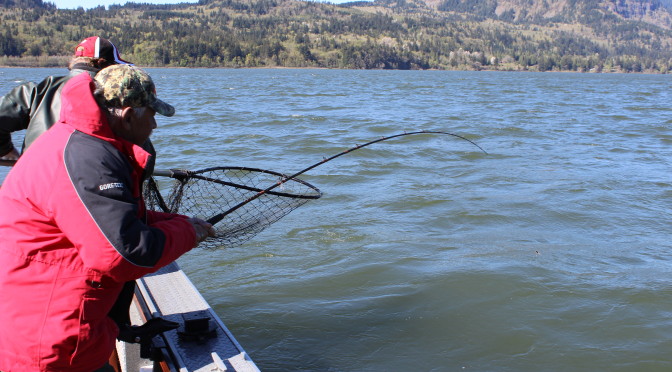
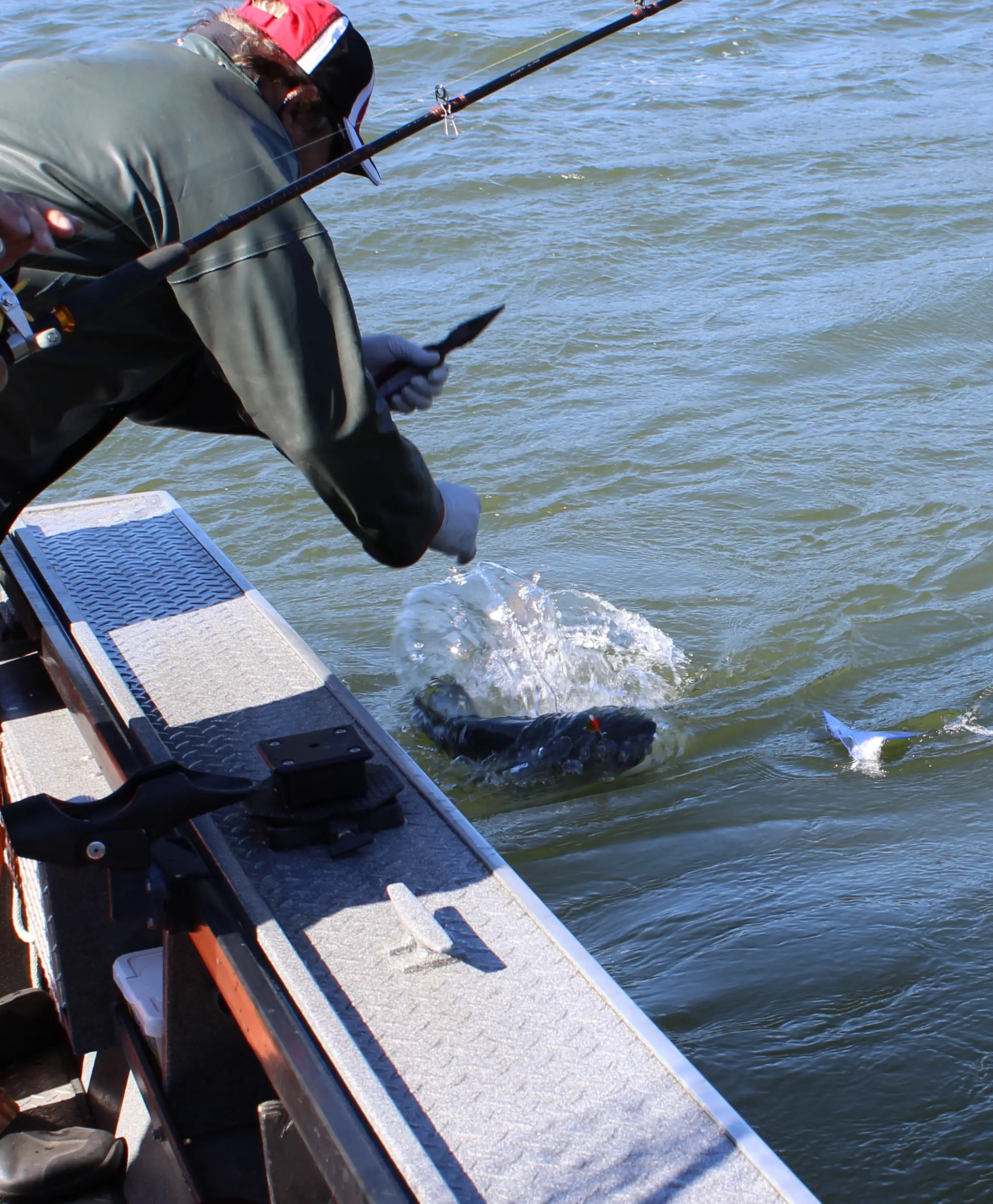
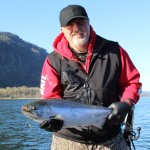
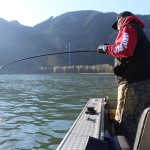
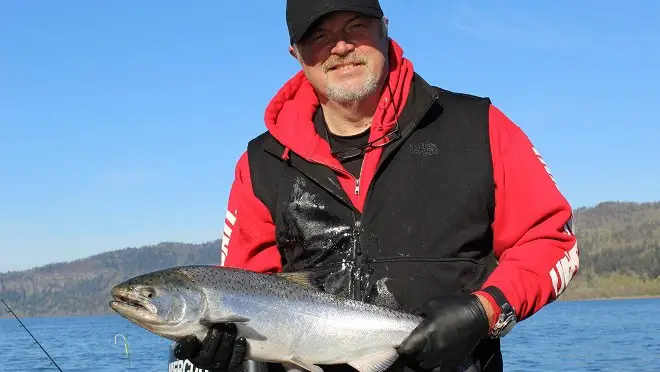
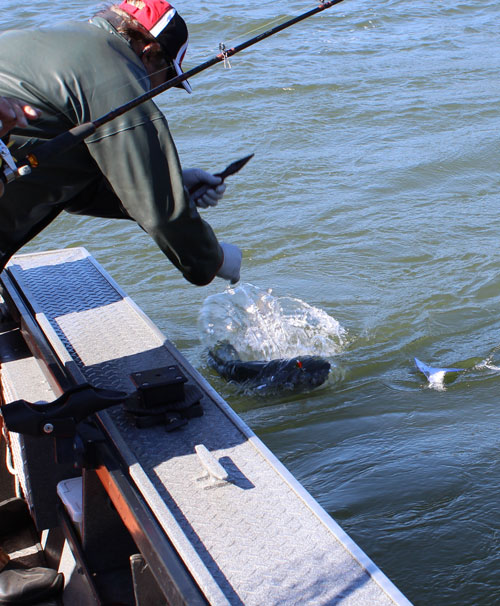
-2.jpg)